Located in Kootenay National Park, the pools at Radium Hot Springs Aquacourt feature hot mineral waters nestled in a dramatic canyon setting.
No hiking boots are required to visit this accessible attraction for all ages and abilities. Odorless mineral waters flow year-round; fall and winter bring rising steam on cold mornings, and with summer, sunbathing and cold plunges help visitors beat the heat.
Read on to soak in the history of the facility, the improvements being made, and how you can experience these historic mineral waters.
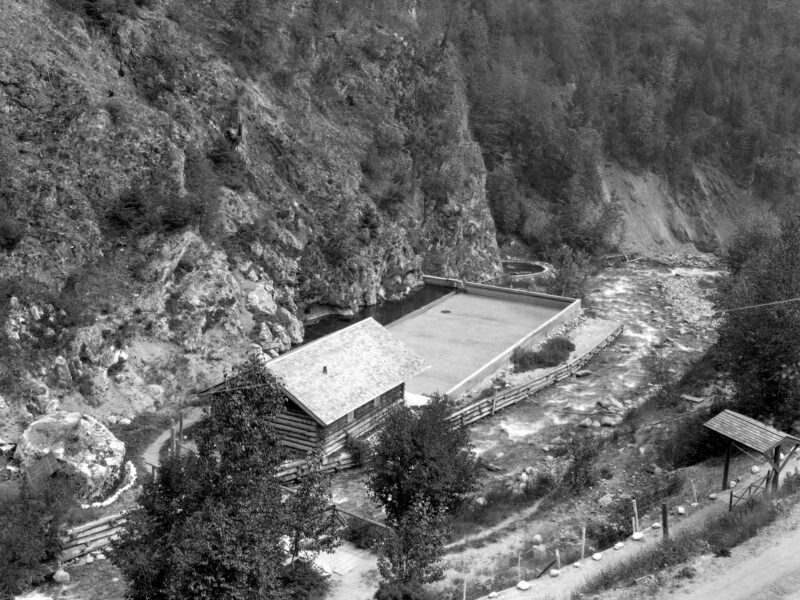
1923 Radium Hot pool with log dressing room
History
Since time immemorial, the hot springs have been a site of health and relaxation for Indigenous peoples. Since the late 1800s, visitors to the area have enjoyed the hot springs, from dipping in natural rock pools to a concrete pool with a log bathhouse, and the current ‘modernist style’ 1951 Aquacourt.
The first registered property owner of the springs from 1880-1922 was Roland Stuart. He initially named the location Sinclair Springs for the spring's proximity to the iconic Sinclair Canyon (the namesake of John Sinclair, an early settler in the area). Later the location was renamed Radium Hot Springs following the discovery of trace amounts of radon in the water. Visitors flocked to “take the healing waters”, popularized by the famous Banff Upper Hot Springs counterpart.
The hot springs were a driving force in the development of Kootenay National Park, the Banff-Windermere Highway (93s), and in the establishment of the Radium Hot Springs townsite. The early 1920s were marked by the explosion of automobile tourism. With the completion of the Banff-Windermere Highway in 1923, a new Tudor/rustic-style bathhouse was developed by the National Parks branch serving weary road travelers. In 1949, fire destroyed this building, making way for the current Aquacourt.
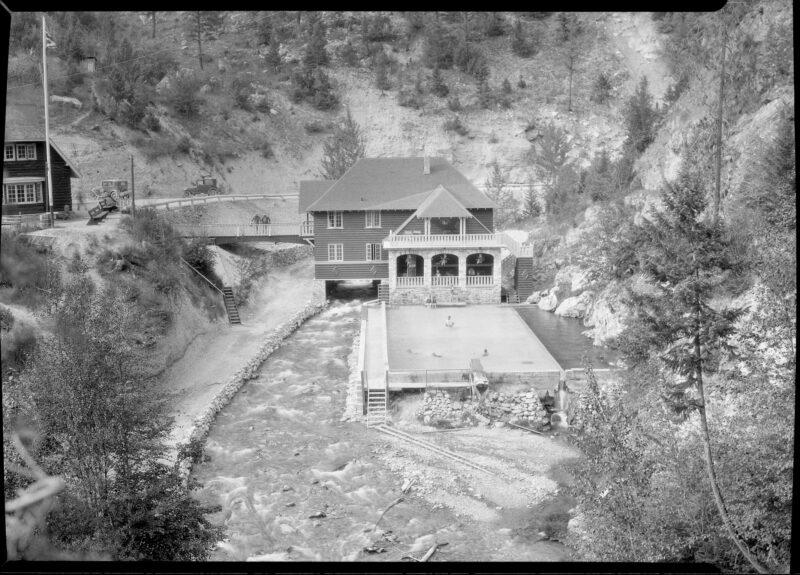
Radium Hot Springs 1926/27 Bathouse and pool. Credit Byron Harmon, Whyte Museum
The modernist-style Aquacourt was the first major post-war building project in the western mountain parks. It took three years to complete. When the building opened in 1951, it featured steam and massage rooms, a coffee bar, an elevator for wheelchair-bound patients, a roof terrace for sunbathers and spectators, and a new cool pool equipped with three diving boards and underwater lighting. By the late 1950’s the Aquacourt was a center of activity in the Columbia Valley, featuring everything from precision diving displays to swim meets, concerts on the sundeck, and interpretive film screenings.
Today, the design features of the Aquacourt have been preserved and maintained as a Classified Federal Heritage Building. Over 70 years after opening, visiting the Radium Hot Springs Aquacourt remains a must-see attraction in Kootenay National Park.
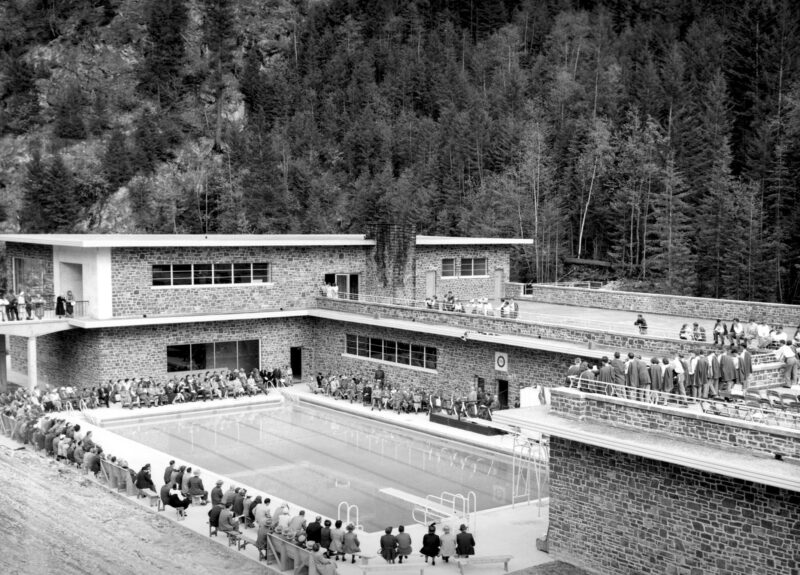
A view of the cool pool during the 1951 Aquacourt opening
Revitalization
Visitors to the Aquacourt in 2023 may be familiar with signs of construction and an imposing blue crane towering over the site. The hot pool remains open while the facility’s 25m cool pool is undergoing a much-needed makeover.
Recent improvements to revitalize the 1951 building include:
- Modernized changerooms
- A new rooftop sundeck
- The introduction of green technology to capture excess geothermal energy generated by the hot spring
- Protection of the building foundation from the rushing water of Sinclair Creek which runs underneath the structure.
The cool pool is also being modernized as it has not seen upgrades in 25 years. When construction is complete in the fall/winter of 2023, visitors will enjoy improved amenities including heated decks, faster lane swim experience with reduced waves, and an accessible lift for mobility-limited users.
Major investments in the restoration of the Radium Hot Springs Aquacourt ensure this heritage experience is available for future generations of Canadians to enjoy.
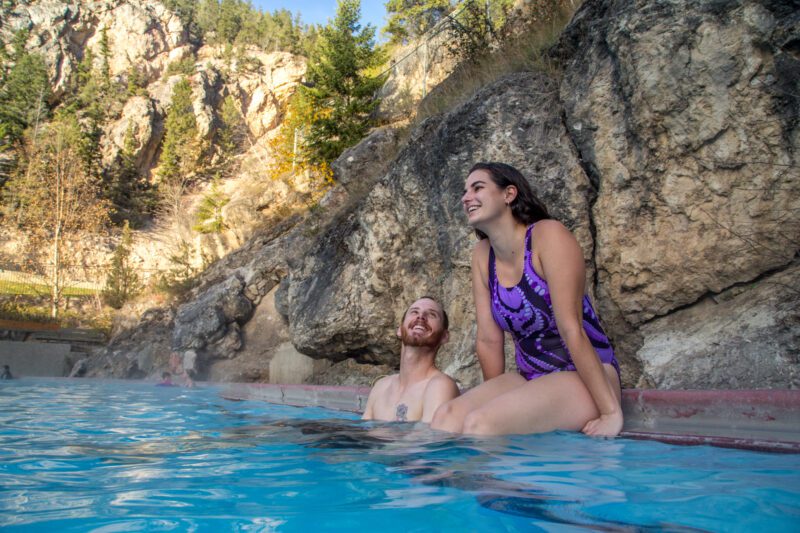
How to visit
Radium Hot Springs is accessible to a wide range of visitors, from families to those with mobility restrictions. From the larger parking lot (north side of Highway 93s) take the stairs into a tunnel for an interpretive journey about wildlife and crossing structures, great for families with young kids. Alternatively, a ramp from the smaller parking lot (south side of Highway 93s) allows wheels to roll to the entrance with ease from accessible parking stalls.
When traveling in Kootenay National Park, consider taking a dip in these natural and historical waters. During construction, the hot pool remains open, and a cold plunge pool provides a way to beat the heat.
Entry to Radium Hot Springs is first come, first served and admission may only be purchased in person at reception. Towels and both modern and 1920s heritage-styled swimsuits are available for rent for the perfect photo op. The facility is open year-round, including on all Canadian Holidays.
For hours of operation and pricing, visit hotsprings.ca
Learn more about accessibility at Radium Hot Springs here.
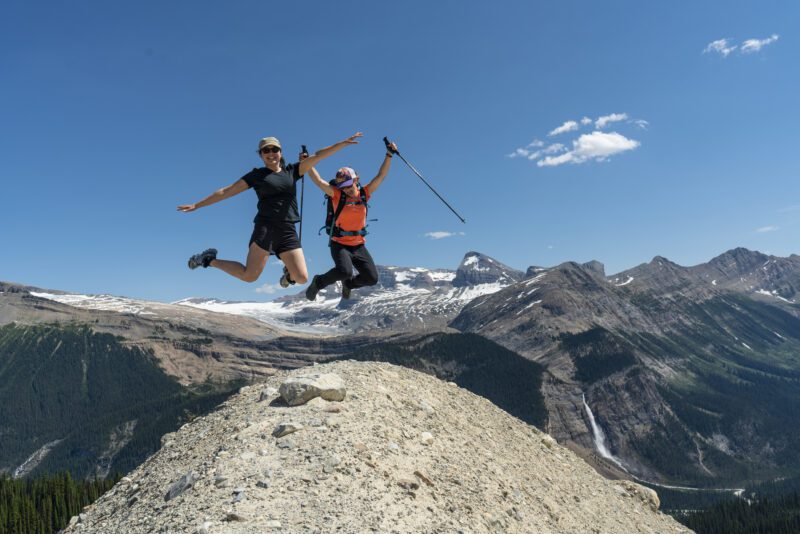 Strap on your hiking boots! Visiting one of Canada’s national parks is a thrilling adventure whether it is your first or your one hundredth visit. The spectacular wilderness, awe-inspiring views, and jewel-toned lakes of the mountain national parks draw millions of visitors every year.
Like any trip, advanced planning will set you up for success and help you tick off those bucket list items with ease. So, let’s talk about what you need to know when touring the Golden Triangle and visiting the mountain national parks.
A national park. What does that mean?
Along your journey through the Golden Triangle, you will pass through 3 separate and unique national parks. Yoho, Kootenay and Banff. Long before park designation, these lands and waters were the traditional territories of Indigenous groups such as the Ktuxnaxa and Secwépemc Nations who stewarded these places.
Starting as early as 1885, park lands were established to preserve and protect the unique and spectacular mountain wilderness so that the landscapes can be enjoyed long into the future. In Canada, national parks are protected under the Canada National Parks Act. The primary goal of Parks Canada is to protect the ecological integrity of the land and waters while allowing visitors to explore, learn, and connect with natural spaces in unique regions across Canada.
What does this all mean? It means, these places are special, and there are certain rules you are expected to know and follow when visiting here that will help protect the incredible wildlife and the unique environment.
Strap on your hiking boots! Visiting one of Canada’s national parks is a thrilling adventure whether it is your first or your one hundredth visit. The spectacular wilderness, awe-inspiring views, and jewel-toned lakes of the mountain national parks draw millions of visitors every year.
Like any trip, advanced planning will set you up for success and help you tick off those bucket list items with ease. So, let’s talk about what you need to know when touring the Golden Triangle and visiting the mountain national parks.
A national park. What does that mean?
Along your journey through the Golden Triangle, you will pass through 3 separate and unique national parks. Yoho, Kootenay and Banff. Long before park designation, these lands and waters were the traditional territories of Indigenous groups such as the Ktuxnaxa and Secwépemc Nations who stewarded these places.
Starting as early as 1885, park lands were established to preserve and protect the unique and spectacular mountain wilderness so that the landscapes can be enjoyed long into the future. In Canada, national parks are protected under the Canada National Parks Act. The primary goal of Parks Canada is to protect the ecological integrity of the land and waters while allowing visitors to explore, learn, and connect with natural spaces in unique regions across Canada.
What does this all mean? It means, these places are special, and there are certain rules you are expected to know and follow when visiting here that will help protect the incredible wildlife and the unique environment.
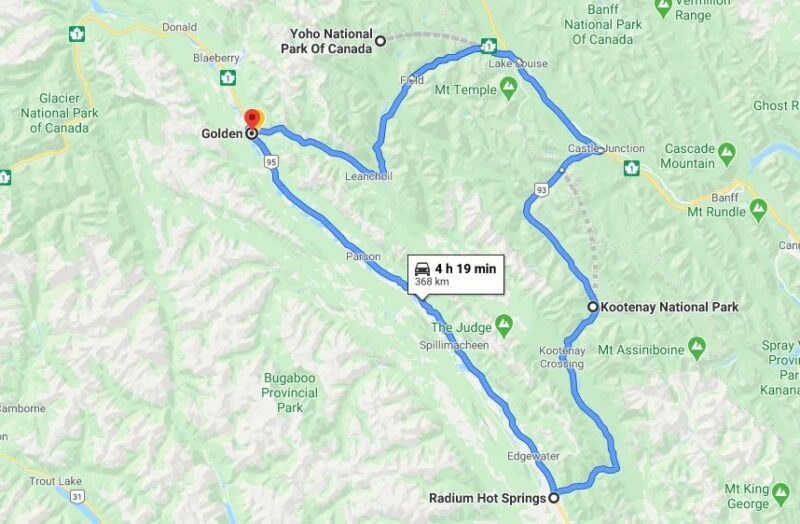 Know before you go.
When considering a visit to the other side of the Rockies, knowing where to go and how to behave will help you maximize your time here and prevent some common pitfalls. Here are some some of our top tips:
Get your Pass: To keep it simple, all visitors to a National Park in Canada must have either a National Park Day Pass, or an annual pass known as a “Discovery Pass”. Admission fees help maintain these places and allow amenities (like interpretive signage and trails) to stay in good repair. A day pass is good for the day you purchased it until 4 p.m. the next day. A discovery pass provides you with unlimited admission to all participating national parks, national marine conservation areas and national historic sites and it is valid for 12 months from the date of purchase! If you will be visiting Parks Canada places for more than 7 days this year, the discovery pass is worth the cost. When touring the Golden Triangle, you can purchase your Parks pass at:
Know before you go.
When considering a visit to the other side of the Rockies, knowing where to go and how to behave will help you maximize your time here and prevent some common pitfalls. Here are some some of our top tips:
Get your Pass: To keep it simple, all visitors to a National Park in Canada must have either a National Park Day Pass, or an annual pass known as a “Discovery Pass”. Admission fees help maintain these places and allow amenities (like interpretive signage and trails) to stay in good repair. A day pass is good for the day you purchased it until 4 p.m. the next day. A discovery pass provides you with unlimited admission to all participating national parks, national marine conservation areas and national historic sites and it is valid for 12 months from the date of purchase! If you will be visiting Parks Canada places for more than 7 days this year, the discovery pass is worth the cost. When touring the Golden Triangle, you can purchase your Parks pass at:
- Tourism Radium Visitor Information Centre
- Tourism Golden Visitor Information Centre
- Any Parks Canada visitor Information Centre, park gate or electronic kiosk
- Online in advance
DYK: all brochures and visitor guides are available for download in advance of your trip. You can also find this information on the Parks Canada App.
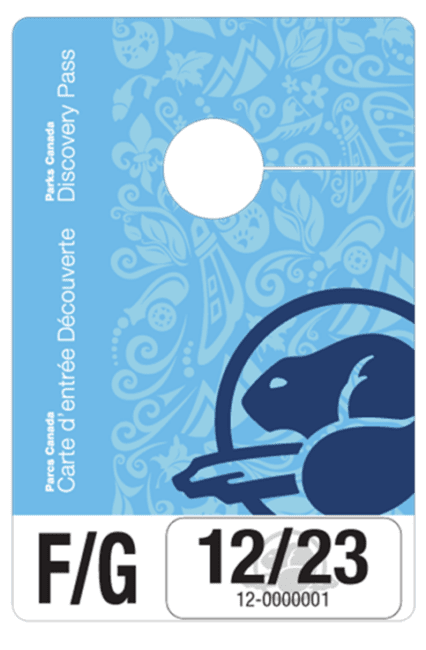 Reserve in advance.
These special places are extremely popular in the summer months (May – October). Access to most trails and day-use areas are first-come first-serve and parking areas can fill quickly. To create some certainty in your trip we recommend booking campsites and guided experiences with as much notice as possible. The Parks Canada Reservation Service is your one-stop shop for front-country and backcountry campsites, glamping accommodations like oTENTiks, and day-use tickets for guided hikes and transit (where offered). Reservations open in January or February most years and are in high demand. Can’t find what you’re looking for? Check back often as cancellations can happen. Also, most locations do have some first-come first-served spots and there are additional accommodators in the Village of Radium, the Town of Golden, and the community of Field.
Closer to your trip, be sure to check the Parks Canada website or contact the Visitor Information Center to find out what locations are open, what conditions to expect, how to prepare, and what services are available before you travel. This will help you select activities that fit your level of skill and knowledge, what gear will be required for your trip, and what accessible options and accommodations are available throughout the park.
Visitor guidelines you might not know about.
We’ve already mentioned this place is special and we need your help to keep it this way. Yoho, Kootenay, and Banff national parks are home to hundreds of species, including grizzly bears, wolves, elk, and more (not to mention all the birds, fish, reptiles, and insects). These animals rely on the unique ecosystem for their survival so protecting it should be a top priority. Here are some things you may not think about when visiting a national park that are extremely important:
Reserve in advance.
These special places are extremely popular in the summer months (May – October). Access to most trails and day-use areas are first-come first-serve and parking areas can fill quickly. To create some certainty in your trip we recommend booking campsites and guided experiences with as much notice as possible. The Parks Canada Reservation Service is your one-stop shop for front-country and backcountry campsites, glamping accommodations like oTENTiks, and day-use tickets for guided hikes and transit (where offered). Reservations open in January or February most years and are in high demand. Can’t find what you’re looking for? Check back often as cancellations can happen. Also, most locations do have some first-come first-served spots and there are additional accommodators in the Village of Radium, the Town of Golden, and the community of Field.
Closer to your trip, be sure to check the Parks Canada website or contact the Visitor Information Center to find out what locations are open, what conditions to expect, how to prepare, and what services are available before you travel. This will help you select activities that fit your level of skill and knowledge, what gear will be required for your trip, and what accessible options and accommodations are available throughout the park.
Visitor guidelines you might not know about.
We’ve already mentioned this place is special and we need your help to keep it this way. Yoho, Kootenay, and Banff national parks are home to hundreds of species, including grizzly bears, wolves, elk, and more (not to mention all the birds, fish, reptiles, and insects). These animals rely on the unique ecosystem for their survival so protecting it should be a top priority. Here are some things you may not think about when visiting a national park that are extremely important:
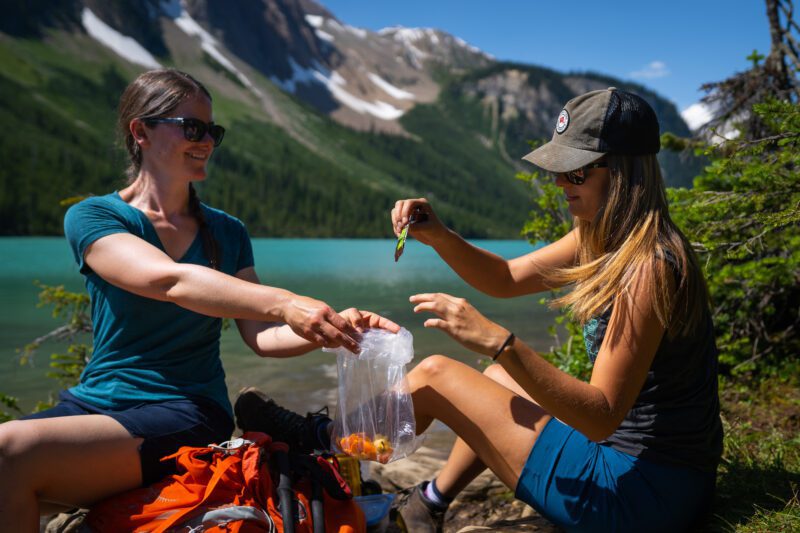
- Dispose of Garbage – We know you know this one, but did you know “garbage” includes things like apple cores and banana peels? Even though many items will eventually compost, they are not native to this landscape and can cause harm to some of the creatures that live here. Orange peels take 6 months to decompose, and cigarette butts can take up to 10 years! With 450,000 km2 of protected land, there’s no way we can pick up after everyone!
- Never Feed Wildlife – Wildlife can quickly find any food, scented items, or garbage that is left unattended. When they eat these unnatural foods, fauna learn to approach people for an easy meal. This can result in aggressive behavior that puts both people and wildlife at risk of being hurt or killed.
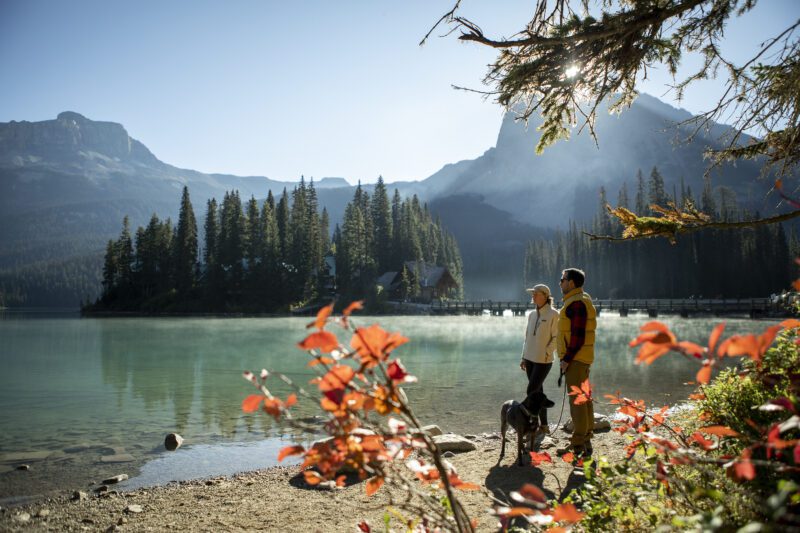
PC: Abby Cooper
3. Keep your pet on a leash at all times – It is against the law to have your pet off-leash in a national park and some trails aren’t pet-friendly. While we are certain your pooch pal is well-behaved, some animals act unpredictably in new situations. Off-leash dogs can trigger aggressive behaviour from wildlife such as grizzly bears and elk, or harm smaller animals. Keep your pet AND wildlife safe by knowing where they are welcome and keeping them on leash and under control.
4. Give wildlife space – Seeing a wild animal in its natural habitat is one of the most special encounters you can have! Keep wildlife wild by making noise on trails, carrying bear spray, and giving lots of space when on the trail. When traveling in your car, be sure to obey the speed limit as animals can often run across the highway. If you see an animal pull completely off the road, take a quick photo and move on. Most importantly stay in your vehicle
5. Leave no trace - Did you know? It is actually illegal to collect plants, mushrooms, berries, animals, animal parts (including antlers), fossils, driftwood, rocks, and other historical or natural objects. Leave with nothing but memories (and a bunch of great photos of course). This also applies to staying on the trail. Off-trail use can damage sensitive plants and erode soil.
6. Avoid restricted areas – occasionally trails can be closed for construction or to keep wildlife and visitors safe. Always come with a backup plan for your hike or picnic area. If an area you plan to visit is closed, please come back another day.
7. No drone zone - It's true, nobody is allowed to fly a drone in a national park without a special exemption. But don't take it too personally — flying any aircraft in a national or provincial park is prohibited, and drones just happen to fall into that category. So please leave your helicopters gliders and jets at home as well.
We think this place is pretty special and we know you will agree. Thank you for helping to protect this special place and keep it wild for all to enjoy.
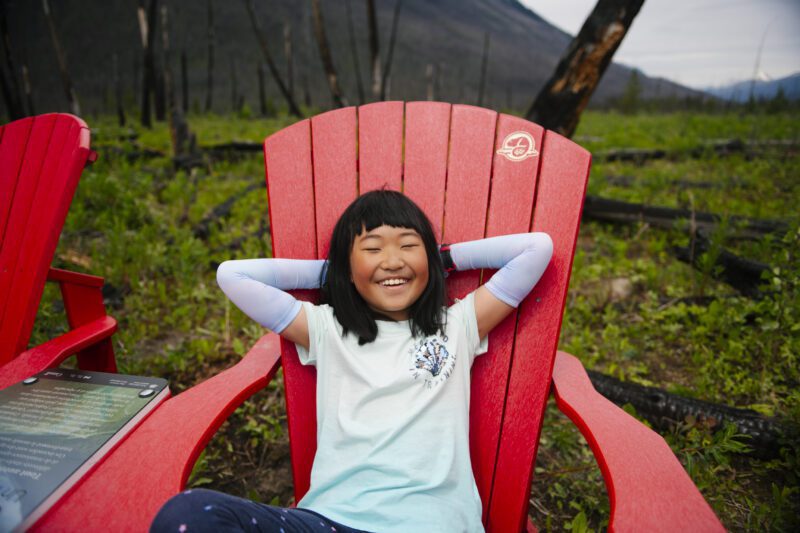
Roadtripping the Canadian mountains is one of the most iconic ways to explore Canada and British Columbia. Meet the Golden Triangle, a route through the Rockies and their ancient cousins, the Purcells.
Placed perfectly between the drastic peaks of Yoho National Park and the running rivers of Kootenay, you’ll find the community of Golden tucked away at the foot of the Columbia Wetlands. Further down the valley, you’ll bump into the Village of Radium, making these two communities incredibly convenient to explore the National parks from. This is precisely what makes the Golden Triangle so perfect.
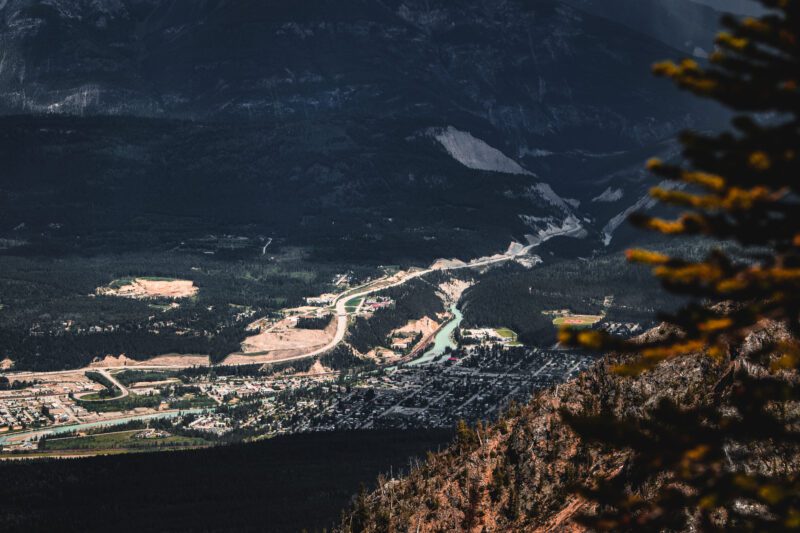
Credit: Andrew Chad
Move Slow in Golden
Whether Golden is your first overnight stop on the Triangle or the second, you’ll find a balance of adventure and relaxation here. Pulling into Golden, you’ll meet a lively little town and quaint businesses along a main drag. The really neat thing about Golden is how accessible the different parts of town are through the trail system. The Rotary trail is a maintained path that connects the main part of downtown to residential areas, and forested groves, and will take you right to the banks of the confluence of the Columbia and Kicking Horse Rivers.
After those big adventure days in the Parks, the Rotary trail is a lovely way to slow down and relax. It’s accessible by foot, bike, adaptive bike, or electric chair and it is maintained throughout winter & summer seasons.
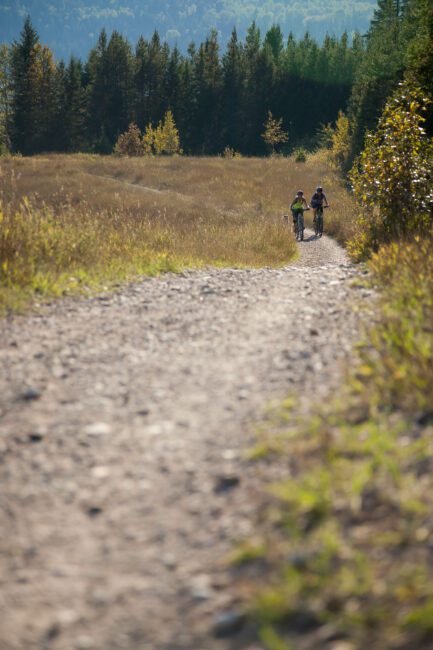
Credit: Dave Best
Dining Right
Another perk of the Rotary Trail is that it connects many of Golden’s delicious restaurants, pubs, cafes, and even our brewery. Use the trail to get to your dinner reservation downtown, or stop in for a pint at the Whitetooth Brewery on your way to the river. Golden has a variety of dining options, with signature mountain eats (like the burgers at the Wolf's Den), high dining (Eleven22), and adorable, fresh cafes and bakeries. You can learn more about places to eat in Golden here.
Visit the Visitor Centre
What better way to prepare for your journey on the Golden Triangle than by talking to the people who are waiting to talk to you? Up at the Golden Visitor Centre, friendly information counsellors are available to discuss your route and everything you need to know about it.
You’ll need a Park Pass to explore Yoho & Kootenay, and you can purchase these at the Visitor Centre. They also have free trail maps and personal recommendations on activities and accommodations in town. Read the blog: Plan Ahead for the Parks to learn about everything you need to know before you visit the National Parks.
The counsellors at the Visitor Center will have plenty of recommendations for you. Among them might be:
- Head up to Kicking Horse Mountain Resort for a mountain adventure. Rent downhill bikes, explore the peaks by foot, dine on the summit, and see Boo the local Grizzly Bear.
- Spend your day at the local adventure park, the Golden Skybridge, with ziplines, a mountain caster, a giant swing, axe throwing, and more.
- Catch an epic Columbia Valley sunset at the best lookout spot in Golden: Mount 7. You can drive up to Mount 7, or the part of it called the “launch pad” where downhill bikers & paragliders both launch themselves over the edge of the mountain and cruise all the way down to the valley bottom. Mount 7 is iconic for the 7 that appears along the face of the mountain every spring during snow melt, as well as for the views you can get when you picnic at the launch pad. This is, undoubtedly, the best way to wrap up your stay in Golden before you head out to explore the rest of the Triangle.
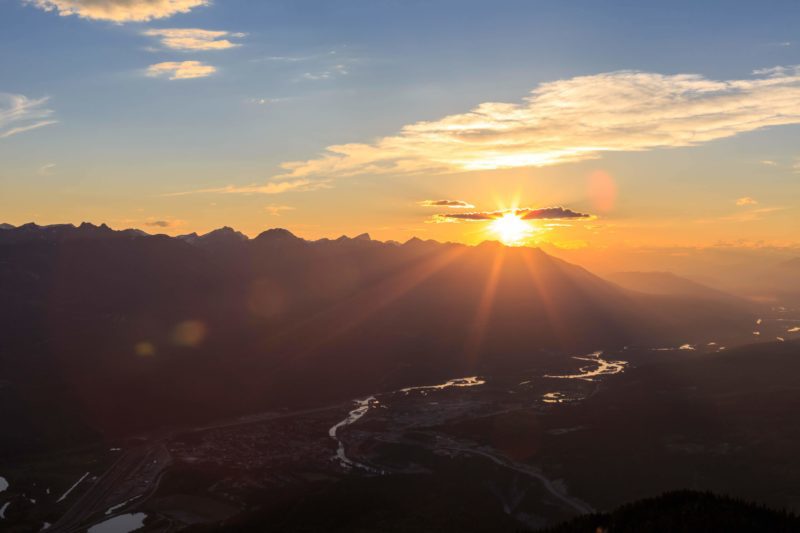
Credit: Dave Best
Plan Your Trip to the Village of Radium!
Whether you have allocated a few days to explore the Village or an action-packed afternoon along your Golden Triangle road trip, there are some must-see spots in Radium Hot Springs! Make the most of your trip and be sure to include time for the must-see attractions.
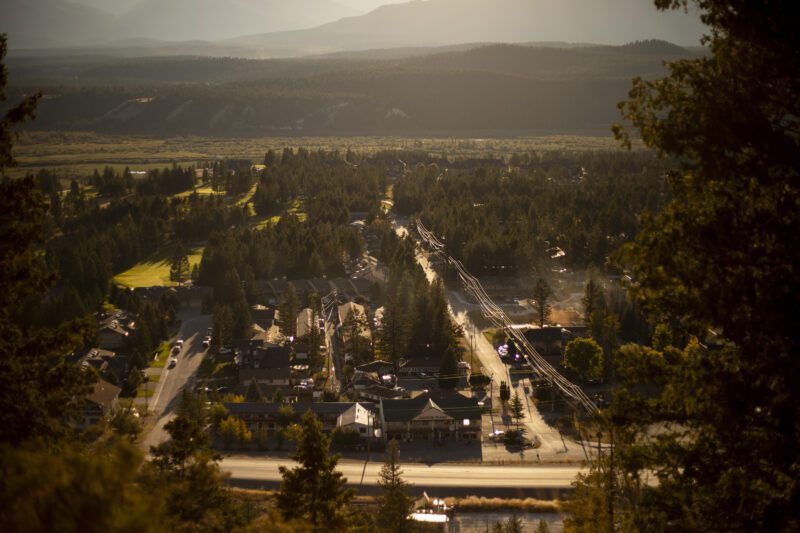 Take in Nature
Calling all bird lovers! Did you know? Radium Hot Springs is an ideal place to bird-watch. A great place to start is at the Old Coach Trail, overlooking the beautiful Purcell Mountains and the Columbia River Wetlands. The Wetlands are home to over 267 species of birds and many other types of mammals, insects, amphibians, and fish. Those visiting Radium will also love to see the iconic Bighorn Sheep roaming the Village, spotted most frequently in the autumn.
Soak in the Hot Springs
Stop in for a soak at the namesake Radium Hot Springs pools! Bring your own towel and bathing suit, or rent some at the entrance. Plan for a few hours to soak in the relaxing thermally heated, odorless mineral waters of the Hot Springs pools.
Radium Hot Springs pools operating information >
Take in Nature
Calling all bird lovers! Did you know? Radium Hot Springs is an ideal place to bird-watch. A great place to start is at the Old Coach Trail, overlooking the beautiful Purcell Mountains and the Columbia River Wetlands. The Wetlands are home to over 267 species of birds and many other types of mammals, insects, amphibians, and fish. Those visiting Radium will also love to see the iconic Bighorn Sheep roaming the Village, spotted most frequently in the autumn.
Soak in the Hot Springs
Stop in for a soak at the namesake Radium Hot Springs pools! Bring your own towel and bathing suit, or rent some at the entrance. Plan for a few hours to soak in the relaxing thermally heated, odorless mineral waters of the Hot Springs pools.
Radium Hot Springs pools operating information >
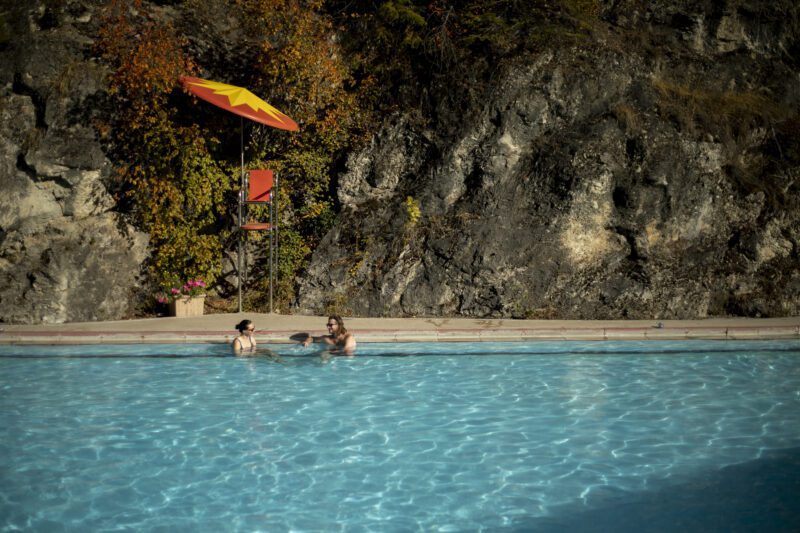 Hike the Trails
Whether you’re looking for an all-day adventure or an after-dinner stroll, the trails in and around Radium Hot Springs have got you covered.
Hiking in Radium >
Explore Main Street
Peruse the local shops and activities of Main Street in Radium Hot Springs. Pick up a sweet treat at the candy shop or peruse local artisans.
Hike the Trails
Whether you’re looking for an all-day adventure or an after-dinner stroll, the trails in and around Radium Hot Springs have got you covered.
Hiking in Radium >
Explore Main Street
Peruse the local shops and activities of Main Street in Radium Hot Springs. Pick up a sweet treat at the candy shop or peruse local artisans.
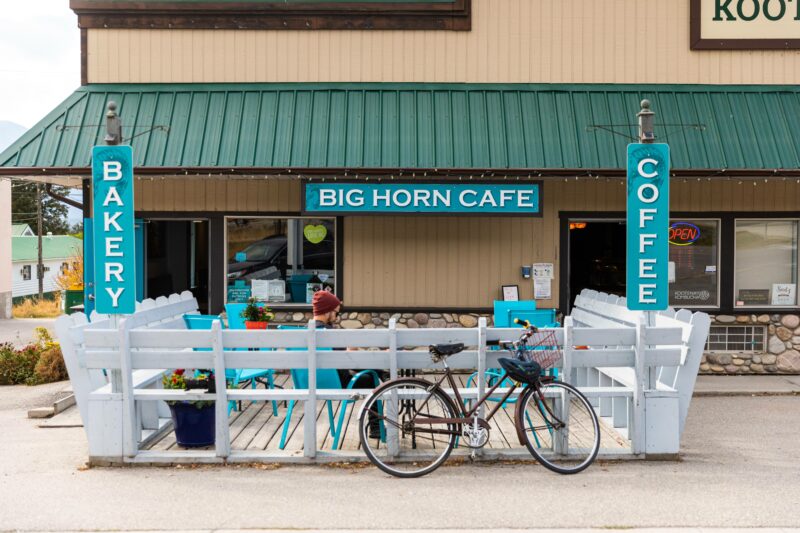 Stop at the Sinclair Canyon
Take in the Sinclair Canyon, the magnificent entrance to Radium Hot Springs from Kootenay National Park, for a great view and photo opportunities. Hikers can continue on the trails up to the top of the canyon, or down to the Sinclair Falls.
Visit the Visitor Centre
Your adventure starts at the Radium Visitor Centre! Stop by for intel on the best things to do and places to see, according to locals. Pick up any maps, activity suggestions, and information you may need at the Visitor Centre, open daily from 9 a.m. - 5 p.m. While you’re there, make sure to visit the interpretive displays to learn more about wildlife and the Ktunaxa people.
Visitor Centre Hours & Location >
Take in the Views
There are many scenic spots and pullouts to check out in Radium! From the roadside pullouts on Highway 93/95 (just south of Radium Hot Springs) overlooking the Columbia River Wetlands to the bright green Olive Lake in Kootenay National Park to the birds-eye view of town at the Valley View Lookout, you don’t have to travel far to earn good views.
Stop at the Sinclair Canyon
Take in the Sinclair Canyon, the magnificent entrance to Radium Hot Springs from Kootenay National Park, for a great view and photo opportunities. Hikers can continue on the trails up to the top of the canyon, or down to the Sinclair Falls.
Visit the Visitor Centre
Your adventure starts at the Radium Visitor Centre! Stop by for intel on the best things to do and places to see, according to locals. Pick up any maps, activity suggestions, and information you may need at the Visitor Centre, open daily from 9 a.m. - 5 p.m. While you’re there, make sure to visit the interpretive displays to learn more about wildlife and the Ktunaxa people.
Visitor Centre Hours & Location >
Take in the Views
There are many scenic spots and pullouts to check out in Radium! From the roadside pullouts on Highway 93/95 (just south of Radium Hot Springs) overlooking the Columbia River Wetlands to the bright green Olive Lake in Kootenay National Park to the birds-eye view of town at the Valley View Lookout, you don’t have to travel far to earn good views.
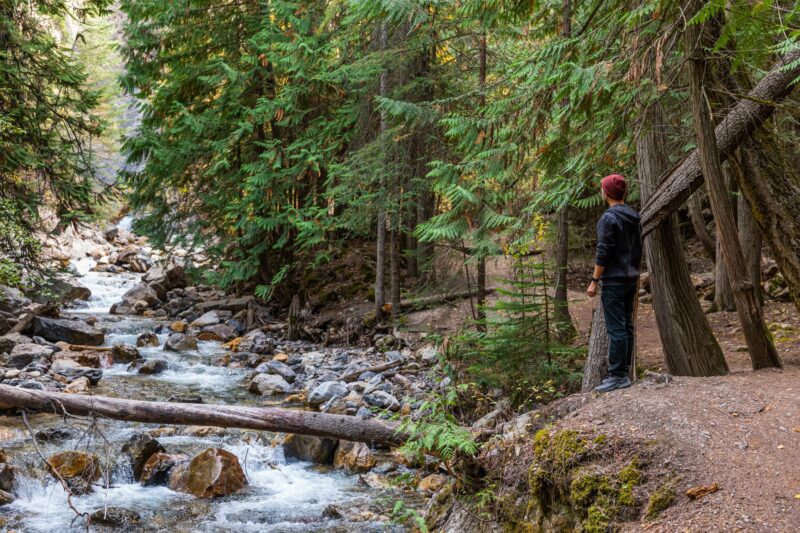 Grab a Bite
Stop in at one of the tasty local restaurants in Radium Hot Springs. Known for local and fresh food, you’ll find a surprising variety of great choices in the charming town.
View all of the restaurants in Radium Hot Springs and make your choice >
Find Your Adventure
Are you ready to raft down the beautifully scenic Kootenay River? Looking to test your skills in an escape room, fly high on a zipline course, or head out on an interpretive guided hike? There are so many activities and adventures in Radium Hot Springs! Find your fit and invite your crew along for an unforgettable experience.
Explore Activities & Adventures in Radium Hot Springs >
Grab a Bite
Stop in at one of the tasty local restaurants in Radium Hot Springs. Known for local and fresh food, you’ll find a surprising variety of great choices in the charming town.
View all of the restaurants in Radium Hot Springs and make your choice >
Find Your Adventure
Are you ready to raft down the beautifully scenic Kootenay River? Looking to test your skills in an escape room, fly high on a zipline course, or head out on an interpretive guided hike? There are so many activities and adventures in Radium Hot Springs! Find your fit and invite your crew along for an unforgettable experience.
Explore Activities & Adventures in Radium Hot Springs >
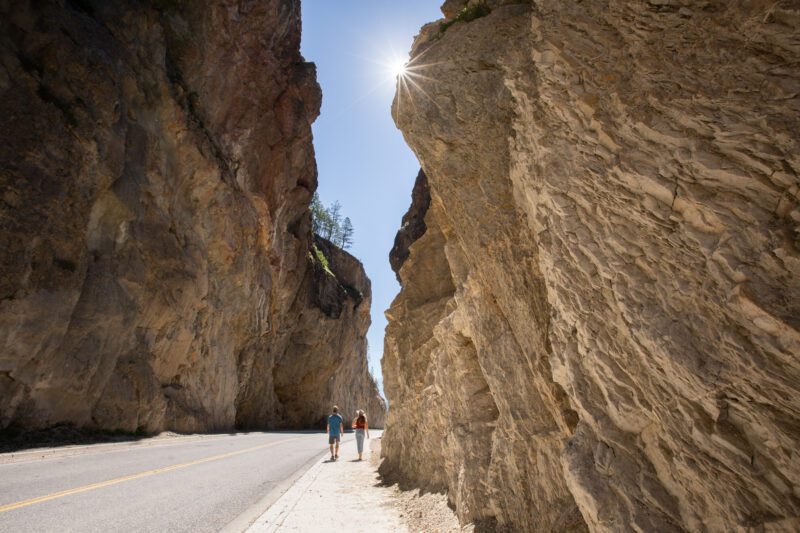 Settle in for a Stay
Find the best place to stay in Radium Hot Springs! With a diverse range of places to stay, check out options ranging from affordable to luxurious. Stay within walking distance to local restaurants and shops, or tuck away to a quiet cabin surrounded by nature.
Explore Places to Stay >
There’s so much to see and do in Radium Hot Springs! Extend your trip for a few days by taking on the Golden Triangle Road Trip to explore the other side of the Rockies. Gain iconic views of the Rockies in two National Parks: Kootenay and Yoho. And spend time in the charming mountain towns of Radium Hot Springs and Golden.
Settle in for a Stay
Find the best place to stay in Radium Hot Springs! With a diverse range of places to stay, check out options ranging from affordable to luxurious. Stay within walking distance to local restaurants and shops, or tuck away to a quiet cabin surrounded by nature.
Explore Places to Stay >
There’s so much to see and do in Radium Hot Springs! Extend your trip for a few days by taking on the Golden Triangle Road Trip to explore the other side of the Rockies. Gain iconic views of the Rockies in two National Parks: Kootenay and Yoho. And spend time in the charming mountain towns of Radium Hot Springs and Golden.
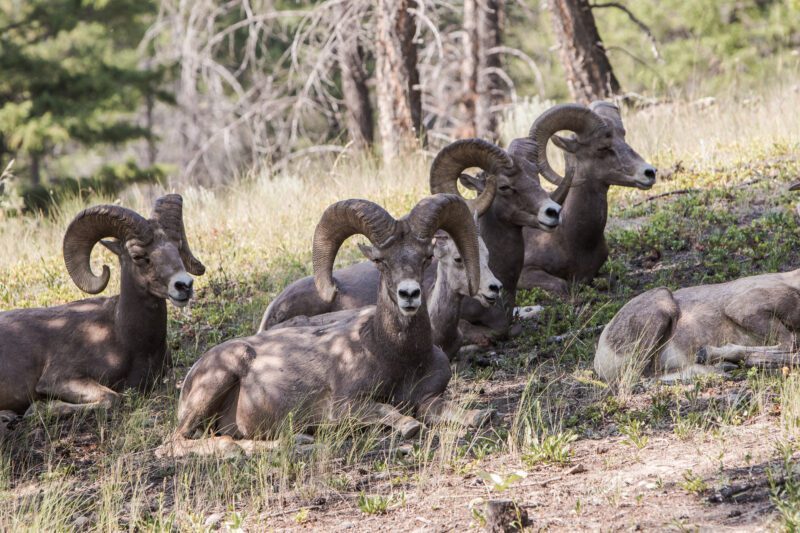
Whether you’re an outdoor sports seeker or prefer admiring nature at a slower pace, a road trip through the Golden Triangle holds many treasures. It’ll take you through two of Canada’s most stunning national parks, Kootenay and Yoho, past waterfalls and lakes and rivers, and into the heart of two authentic mountain communities.
The triangle is a hiker’s delight, there are stop-off trails all along the way, from short jaunts with a view to more strenuous, but rewarding, grinds. And, best of all, you can kick back at night in the towns of Radium and Golden, enjoying the relaxation of Radium’s hot springs or Golden’s epic views.
When you’re on the trail though, you have to be a little more alert. One of the key philosophies of traveling through national parks (and when you spend any time in the wilderness) is responsible travel. This includes considering how you might impact the environments that you visit, it goes beyond making sure to throw your trash in the garbage and considering how you might influence the wildlife that calls these areas their home and the plants, soil, and trees that live there too. In this sense, there are a few tips that you should know before you go…
Be Prepared
You’ve come to the wild to experience exactly that, its wilderness. As majestic as they are, the mountains can be unforgiving with weather changes, terrain, and other elements of nature. Thus, it’s incredibly important that you come prepared for time spent in the wilderness. You can find a full list of packing essentials here, but to get you started you should be bringing:
- Warm layers (even on the hottest day, the weather can turn on a dime)
- Extra food and water
- First aid kit
- Sun protection
Carry Bear Spray
Canada’s mountains are home to both black and grizzly bears. Although the chances of encountering an aggressive bear are low, you should know the “bear-aware” rules to help protect you, your group, and the bears. Carrying bear spray, and knowing how to use it, is one of the first steps. If you see wildlife, keep your distance and let them do their thing, you’re visiting their home after all.
Parks Canada has extensive resources on wildlife and bear safety, you can find that here.
Keep Dogs on Leash
The Golden Triangle is a great trip for you and for your dog too. They’ll love exploring the trails just as much as you do. Please remember to keep them on a leash when you’re in the National parks or exploring the wilderness around Radium and Golden. This is for their health, yours, and for wildlife. Leave no trace and pick up after your pet to make sure that our wilderness stays healthy and vibrant.
Stay on Designated Trails
It can be tempting to roam the forests and step off track on those big open viewpoints. But, alpine environments are fragile and can take a long time to grow and establish themselves. Footsteps can do more damage than you might imagine. Parks Canada has incredibly well-marked trails for just this purpose, to preserve and protect the landscapes we come to visit. Please be conscious of where you put your feet and where you choose to take your hike breaks.
Responsible travel ensures that your adventure is a good experience for you and for everything around you. These landscapes are so enjoyable to visit, and it's vital that we, as travelers, do our part to protect and care for them so that we can keep coming back again and again.
Rich in culture, history, and hosts endless options to explore the landscape - Kootenay National Park is a mecca for outdoor lovers of all abilities. Driving through the park is both a tease of all things you can’t do in one visit and a rewarding journey while taking in the views at the same time - the polarizing feeling always captures my attention and holds me present yet begs me to come back.
Heading East to West on Highway 93 in Kootenay National Park, here are a few of my favourite relatively quick spots to visit. When I say quick, I mean you can see more than one in a day, but the number of places per person will depend on how memorized you become by the beauty, undoubtedly affecting your pace and time behind the lens.
PAINT POTS TRAIL
This 2km round trip is well worth it. A beautiful stroll through open meadows is a nice stretch for the legs and after a small up (25 meters) beside a trickling creek you’ll be greeted by three iron-rich mineral springs. These three small bodies of water are a vibrant orange on the shoreline and a crisp glacial teal in the center. On a still day, they also offer hypnotic reflections of the towering old-growth trees surrounding the open area. The Paint Pots were used to collect pigment for paint first by the indigenous and later by a mining company in the early 1900s which came to a halt when the park was formed. It’s a living piece of history and a sight completely unique to Kootenay National Park. One small tip, if it’s been a rainy week, good waterproof shoes are a good idea as the soft malleable soil often makes the boardwalks to access the area a little less efficient.
NUMBA FALLS
See the Vermillion Rivers’ power up close and personal by turning into the Numba Falls turn-off. The short but strategically placed trail allows you to explore the rushing falls from multiple angles - my favourite is overhead from the bridge. For the slow shutter lover, get here early or late when the falls are in complete shade. The rushing water is so bright mid-day making it harder to capture at this time, but always beautiful to see regardless of the time of day.
SIMPSON RIVER
My personal favourite. The trail features epic vistas and links you to the landscape through a series of new interpretive trails. Capture the Simpson River from above and embrace the 360 views of Kootenay National Park. A perfect place to make the most out of the changing fall colours. I especially love the added charcoal trees against the reds and yellows for a moody stark contrast. The winding trail leads you to a final lookout with the classic red Parks Canada chairs. A fun trail with minimal elevation gain features boardwalks and access to much more than the interpretive trail. This area serves as a gateway to the iconic Mount Assiniboine. Noting that, watch for signage to ensure you do the hike you’re after.
KOOTENAY VALLEY VIEWPOINT
Yes, a viewpoint pull-out makes the list. It’s a picture-perfect picnic location. From here you can see the valley opening towards Radium. It’s also in a slow zone for pedestrians so it doesn’t feel like you’re next to a highway.
SINCLAIR CANYON
As soon as you drive through the rocky canyon beside the hot springs you know you want to do it again because it is truly a jaw-dropping experience. Walking allows you to take it slow enough to take in the impressive canyon’s offerings. Peer over into the river view, learn about the landscape from the interpretive signs and make your way through the passage on foot. Highly recommend this as it just seems to go by way too quickly in the car, not to mention, if the hot springs are next on your list, this is the perfect way to reach them!
RADIUM HOT SPRINGS
Nothing like earning your relaxation and celebrating a great day of exploring with a soak at Radium Hot Springs. Perfect time to tuck the camera away, kick off the hiking shoes and soak in the historical healing grounds of the local First Nations.
VILLAGE OF RADIUM
A stop outside the park, or is it? The village of Radium encompasses all things Kootenay National Park including stunning views, wonderful walking trails and easy access to it all. The town itself hosts beautiful views on the adequately named Valley View Trail is part of the Redstreak Campground trail network. While it might be easy to overlook an “in-town hike” , these trails offer epic views across the valley and can keep my camera entertained with ease.
I always enjoy ending an autumn evening in Radium soaking in the last of the sun and the fall colours from the Radium Brewing patio. Equally, as magical, an early morning watching the valley get painted in sunshine from Big Horn Cafe - especially if the iconic animal decides to stroll by. No matter how you explore Kootenay National Park and Radium, you’ll leave with tired legs and a nourished mind.
Abby Cooper Bio
Over the last decade, Abby has crafted a career in the outdoor industry as a photographer and creative director specializing in remote backcountry locations and culture. Whether for work or pleasure Abby is always on the move, usually in the mountains, and relentlessly uniting the backcountry community. Abby is an advocate for endless education, good communication, more best days ever and fostering communities. @abbydells
Oh, Yoho! One of my absolute favorite places to photograph. A raw and surreal landscape has inquisitive features that stir my curiosity and beg me to visit year after year. It’s a hard list to come up with, but if you had one day to see as much Yoho National Park as possible, or maybe two - these would be my must-visit locations. Regardless if you’re in Yoho for a day, a week or a month, these places are an absolute must!
EMERALD LAKE
A basecamp for adventure. So many offerings from this starting zone including waterfalls, walks, big hikes, traverses, canoe paddles, rustic-luxurious accommodations, rich history, and epic views in all directions. Worth timing a sunrise or sunset here. My personal favorite is sunrise in the fall. Watching the steam come off the pristine lake as the sun warms is stunning. There is a hiking trail along the shoreline of the lake that brings you past a notorious winter avalanche path, with no looming danger in the fall. The open slope is a perfect place to take in all of the autumn colors and get a great view of the historical lodge.
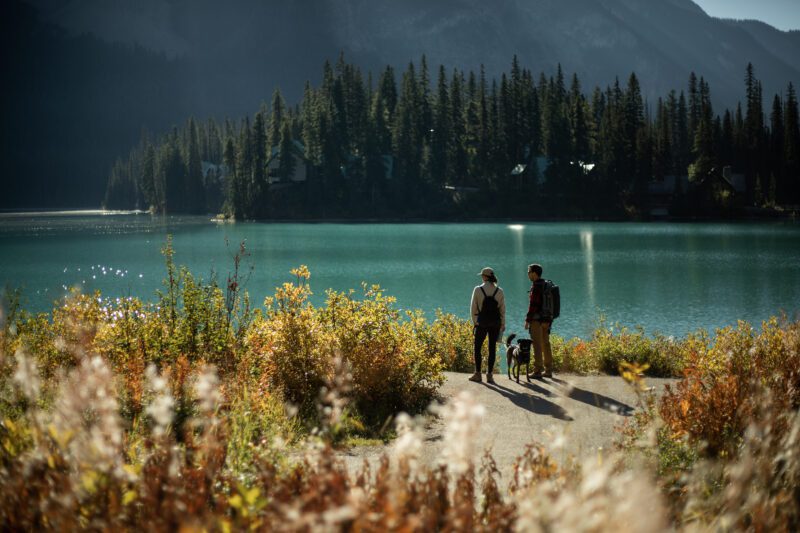 NATURAL BRIDGE
A perfect perch to see the power of the Kicking Horse River in action. Decades in the making, the Natural Bridge is an early riser photographer's dream. In the dark before sun up, the turquoise blue river makes for incredible long exposures as it twirls down, through and out the Natural Bridge rock formations. There is not a bad seat in the house to photograph or take it all in.
NATURAL BRIDGE
A perfect perch to see the power of the Kicking Horse River in action. Decades in the making, the Natural Bridge is an early riser photographer's dream. In the dark before sun up, the turquoise blue river makes for incredible long exposures as it twirls down, through and out the Natural Bridge rock formations. There is not a bad seat in the house to photograph or take it all in.
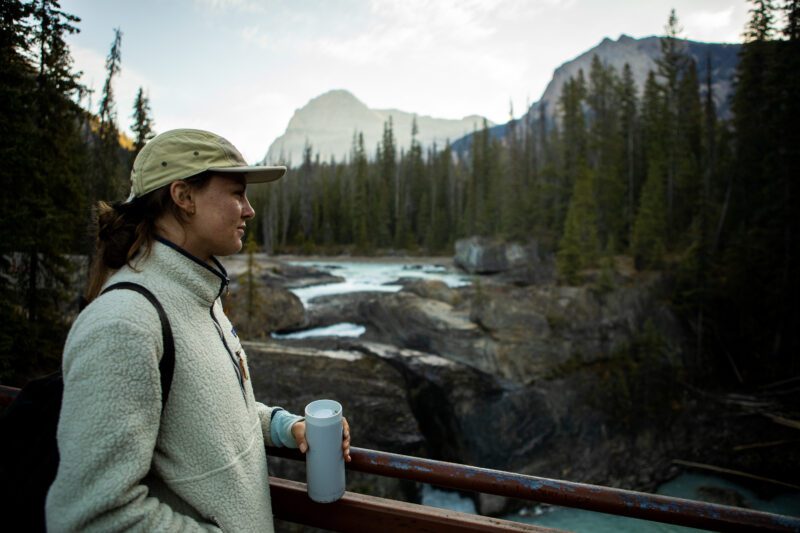 TAKAKKAW FALLS
Magnificent, is the translation from the Cree word Takakkaw and it couldn’t be more accurate for the 373-meter falls. It is the second-tallest waterfall in Canada. A trail winds around with multiple viewpoints, my favorite is right in the midst - while not ideal for the lens, it’s so refreshing to feel the power of this mighty marvel. It’s worth noting that the falls are only in prime daylight for a few hours in the fall if you’d like to evenly expose the water, but no matter the time it’s a humbling place to visit.
TAKAKKAW FALLS
Magnificent, is the translation from the Cree word Takakkaw and it couldn’t be more accurate for the 373-meter falls. It is the second-tallest waterfall in Canada. A trail winds around with multiple viewpoints, my favorite is right in the midst - while not ideal for the lens, it’s so refreshing to feel the power of this mighty marvel. It’s worth noting that the falls are only in prime daylight for a few hours in the fall if you’d like to evenly expose the water, but no matter the time it’s a humbling place to visit.
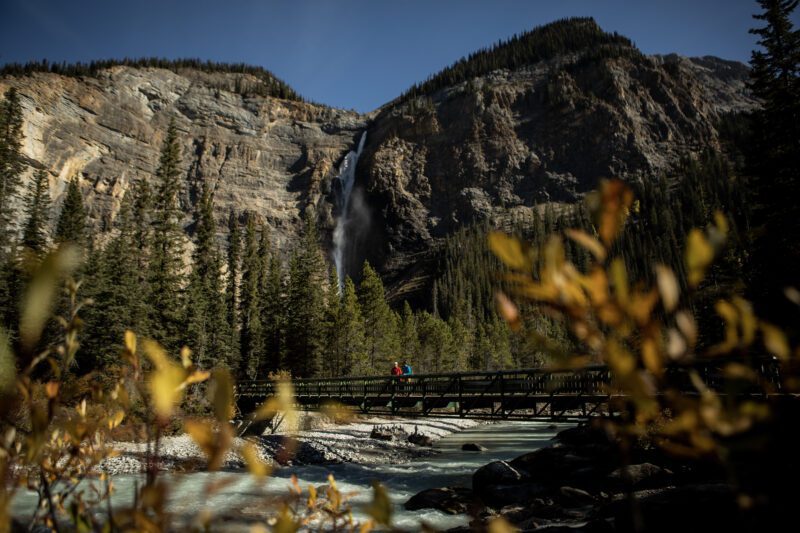 FINN CREEK
Love a good dog-friendly pit stop and Finn Creek is exactly that. The bluest of blue and relevantly calm in the fall, the water makes for a great place to picnic, read a book, relax or take the pup for a stroll or swim.
FINN CREEK
Love a good dog-friendly pit stop and Finn Creek is exactly that. The bluest of blue and relevantly calm in the fall, the water makes for a great place to picnic, read a book, relax or take the pup for a stroll or swim.
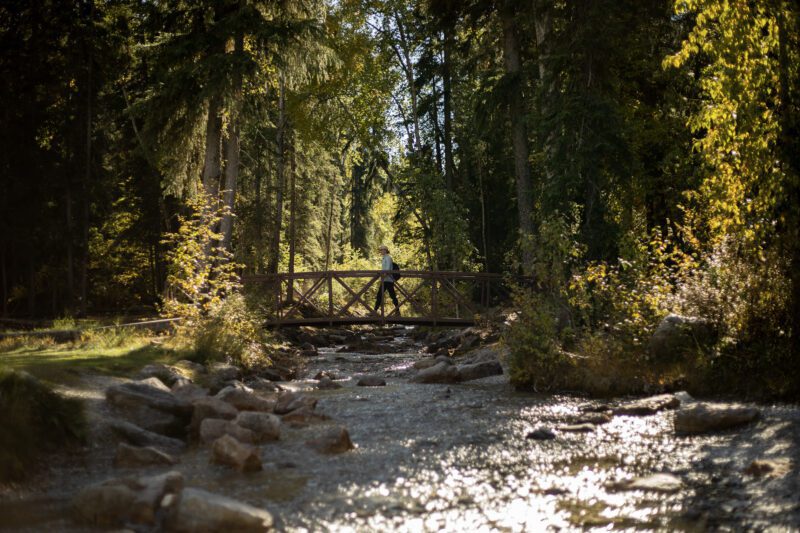 GOLDEN BC
Ah! The epicenter of it all. There’s nothing more perfect than unwinding in Golden and watching the sunset from a patio downtown. No matter which direction you’re facing you’ll have a mountainous view. Golden has access to so many parks, and so many different ranges and offers a humble laidback vibe, it certainly has a soft spot in my heart. No visit to Golden is complete without a stroll downtown, a walk across the pedestrian bridge, and a cheers with a Whitetooth Brewing beer.
GOLDEN BC
Ah! The epicenter of it all. There’s nothing more perfect than unwinding in Golden and watching the sunset from a patio downtown. No matter which direction you’re facing you’ll have a mountainous view. Golden has access to so many parks, and so many different ranges and offers a humble laidback vibe, it certainly has a soft spot in my heart. No visit to Golden is complete without a stroll downtown, a walk across the pedestrian bridge, and a cheers with a Whitetooth Brewing beer.
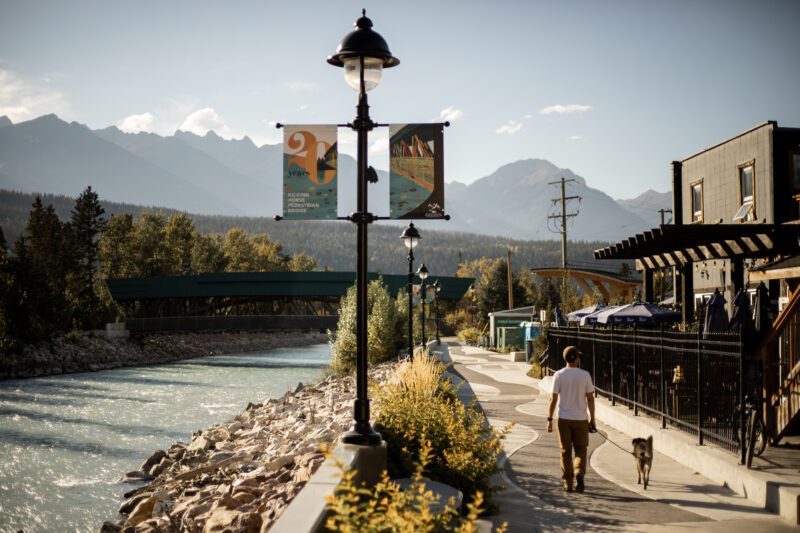 BIG ADVENTURE RECOMMENDATIONS
Known for its epic hikes and beautiful waters, Yoho National Park is connected through a series of vast trail networks. Most hikes have multiple options to make them a half-day, full-day or multi-day - well worth investigating all the options when planning in this playground.
Iceline Trail.
Emerald Triangle.
Sherbrooke Lake.
No matter how many times you visit Yoho or Golden BC you’ll leave craving for more, but no doubt about it. But you’ll also leave fulfilled, accomplished, tried and mentally refreshed - no doubt about that either.
Abby Cooper Bio
Over the last decade, Abby has crafted a career in the outdoor industry as a photographer and creative director specializing in remote backcountry locations and culture. Whether for work or pleasure Abby is always on the move, usually in the mountains, and relentlessly uniting the backcountry community. Abby is an advocate for endless education, good communication, more best days ever and fostering communities. @abbydells
BIG ADVENTURE RECOMMENDATIONS
Known for its epic hikes and beautiful waters, Yoho National Park is connected through a series of vast trail networks. Most hikes have multiple options to make them a half-day, full-day or multi-day - well worth investigating all the options when planning in this playground.
Iceline Trail.
Emerald Triangle.
Sherbrooke Lake.
No matter how many times you visit Yoho or Golden BC you’ll leave craving for more, but no doubt about it. But you’ll also leave fulfilled, accomplished, tried and mentally refreshed - no doubt about that either.
Abby Cooper Bio
Over the last decade, Abby has crafted a career in the outdoor industry as a photographer and creative director specializing in remote backcountry locations and culture. Whether for work or pleasure Abby is always on the move, usually in the mountains, and relentlessly uniting the backcountry community. Abby is an advocate for endless education, good communication, more best days ever and fostering communities. @abbydells
Strolling a path or riding a bike along trails where your only companions are those that live in the wilds is a treat. Finding those gems creates a conundrum though. Do you tell anyone? Or do you keep your treasure to yourself? The good news is, The Golden Triangle is loaded with hidden gems. Here’s a three-day tour to hike, bike and explore the not-so-busy gems. This blog starts in Golden travelling east first but it's easy to do either way.
Golden offers pleasant hikes to fascinating waterfalls
Golden has a couple hikes that are perfect for solitude. A stroll up to Thompson Falls is not just a visit to incredible waterfalls, it’s also a step into Canadian history. The Blaeberry River Valley was used by the Canadian Indigenous peoples and later by David Thompson who mapped the western frontier.
The trail starts at the map kiosk just beyond the Redburn Creek Rec Site campground on the Moberly Road and follows the river for 6 km. If you just want to see Thompson Falls without the journey, continue past the campground 6 km. The Blaeberry River tumbles and snakes though a few tight gorges where logs are still jammed since the spring rush. You can stand on the ledge where water has carved smooth routes through the rock.
South of Golden accessed through Nicholson is a 4 km hike through a dense forest to views of a spectacular deep canyon on the Canyon Creek trail. We have approached the rim on bikes from Moonraker Trails but the hike up from the hamlet is pleasant. It’s steep to start then continues at a steady climb. Canyon Creek is a very narrow gorge demonstrating the power of water etching through soft rock. Insider tip - watch for mountain goats.
Make sure you stay in Golden long enough to stroll across the wooden bridge and stop for a refreshment at any of the new patios fringing the new promenade along the Kicking Horse River.
Yoho National Park offers secret picnic sites, hikes and a tour through historic Field
Yoho may be a small National Park but it packs a punch. So, bring a lunch, your all-weather jackets and bear spray and head for an adventure.
When we hiked the Hoodoo Trail, there were only three other small groups on the trail. And they were all visiting from Europe. Someone must have written about it over there. And with good reason. This short and steep 5.2 km (return) hike rewards the hardy hiker with views of towering hoodoos. The geological gems compete with the conifers for height. They are massive! The trail splits so you can view from below or from above. We did both.
Only minutes from Hoodoo Trail is the Faeder Lake day-use area. Stop in for a quick dip in the shallow mountain lake. Insider tip - walk three minutes to the other side of the lake for an epic photo of Chancellor Peak reflecting in the calm water.
Pack a lunch in your daypack from one of the cafes in Field, and enjoy a picnic along the shores of Sherbrooke Lake. The trail is only 6. 2 km (return) but offers that classic view of towering peaks, glaciers, and wildflowers. If you’d like to add a thigh burner, continue on to the abandoned Paget Fire Lookout. Knowing that it was for spotting fires, you know the view will be unencumbered.
The gems don’t always have to be far from the car. Field is small enough to walk the entire town on a self-guided tour. It has quite the history with the railway and the fossil beds that surround it. There are quite a few B&Bs to tempt you to stay over.
Kootenay National Park and Radium round out your journey
Stanley Glacier hike can be completed in three hours but then, what’s the rush? The trail signs say it’s a moderate hike but that’s because the first bit before you burst through the trees is a bit of a switchback grind. Beyond that, it’s an easy incline surrounded by stunning views. It doesn’t take long to reach the 4.2 km sign, signifying the end of the maintained trail but that’s where it gets really interesting. The additional strenuous 3 km loop takes you to views of Stanley Glacier, under a waterfall, or through rubble that tumbles from the cliffs hiding fossils. My family of amateur paleontologists were sidetracked with the first sighting of a trilobite. Guided hikes are available through Parks Canada if you want to learn more about the fossils.
You don’t need an excuse to say ahhhh in Radium
A soak in the soothing hot springs in Radium is such a luxury. How many pools in the world have such a beautiful backdrop? Sit back and enjoy the experience. Then, take a walk through town. I love the new traffic circle! Not just because it eases the traffic congestion, it has the biggest set of bighorn sheep horns you’ve ever seen. Not exactly hidden but totally a gem! Speaking of Bighorn Sheep, there is a herd that lives near town. It's highly likely you will see them. Stop in town for a Segway tour or drop the bikes off the rack to take a ride on the easy 6 km Sinclair Creek Trail.
The stretch of highway 95 between Radium and Golden follows the sluggish Columbia River. The more it meanders the more wetland habitat for waterfowl and wildlife is formed. I’ve watched so many people in kayaks drift along. Maybe next time it will be me.
.
Do you ever get halfway through a tough section of an adventure and question why you even started it? But then the ridge or the peak come into view, the river bends, and you can see the finish line? That is the adrenaline we all crave. Yes, that effort was worth it. The Golden Triangle, that includes Kootenay and Yoho National Parks, and the mountains, rivers and valleys that connect them between Golden and Radium, offer endless adventures to challenge you to reach that breathtaking goal.
Take a look at the adventures that will plaster that “Yeah, I did it!” smile on your face.
Pick your adventure on Highway 93
Floe Lake accessed from Highway 93 is a classic mountain trail that will test your lungs and legs. At 21 km return with an elevation gain of over 1000 meters it’s a grind. But as always, worth the effort. Shortly after leaving the parking lot the trail crosses two dreamy powder blue rivers before starting the switchbacks. Prior to 2003 it was a dense forest, but the fire cleared that out. Trying to make lemonade out of the tragic loss means I focus on the unobstructed views, the regrowth, and the amazing array of wildflowers blanketing the landscape. A few more switchbacks finally brings Floe Lake into sight surrounded by massive grey layers of sedimentary rocks skirted by mini glaciers that somehow survive the summer heat. Toss down the pack and pull out a snack and watch the shadows move across that view. Consider booking a backcountry camping spot to extend your stay. I can say that the view is gorgeous during a sunset.
Hey, have you stopped in Radium lately? It’s a perfect basecamp for adventure. If your bike is on the bumper, there are hundreds of kilometres to rip. If it’s early June and you are hardcore sign up for the 50 km single track Kootenay Krusher race. If you love trail running, the rolling path through Sinclair Canyon is perfect.
North of Radium, Highway 95 follows the Columbia River as it weaves through a massive wetland. Dropping a paddleboard or a kayak in to drift along the lazy river is a great way to enjoy the afternoon.
Yoho National Park is more than just rocks.
I’m not going to lie; the Burgess Shale Guided Fossil Hikes are a bit daunting but well worth the effort. The guides take a slow steady pace up to either the Mount Stephen Trilobite Beds at 8km round trip and 800 metres of elevation gain, or the 22 km round trip tour to the Walcott Quarry with the same elevation gain. The Walcott Quarry however offers a fossil bed unseen by the rest of the world and a spectacular view of both Takkakaw Falls and Emerald Lake from above. Access to these protected UNESCO sites is forbidden without the guides.
If finding trilobite fossils the size of a football isn’t your fancy, a hike on the top of the world might do the trick. The Iceline Trail can be done as a day trip or spread out over a few days on a loop. We packed for a day hike and with many other back-country enthusiasts, hit the trail at the Takakkaw Falls parking lot. With 3 km of steep switchbacks in the trees, you soon lose the crowds and drink in the views that get better and better. Looking down at Takakkaw Falls – the second tallest waterfall in Canada is surreal.
Finish the day counting stars while camping at any of the National Park campgrounds along the highway. There are soooo many stars up there!
Golden has upped the summertime thrills
My legs were vibrating like a sewing machine jammed on a stitch. I used to be a rock climber, why was this happening! I was clipped in, holding onto the cable with both hands and looking down at the plank path suspended above T1 at Kicking Horse Mountain Resort. My inside voice laughed at me, “You better buck up, princess. You signed on for the longest tour.”
The three-hour Ascension Route was about to take me across the mountain top using iron rung ladders bolted to the rock, steel cables, ladders, rock paths and that dreaded suspension bridge. Don’t worry, within the first few steps, I was my old self leaping out of my comfort zone. Using the secured holds made it easy to maneuver across the chasms, up the rock faces and over the ridges. The joys of seeing the world from the ridges far above the valley was worth all the grunting.
Also in Golden is the new Golden Skybridge with two of Canada’s highest suspension bridges draped 130 metres (426 ft) above the expansive canyon and waterfall. It opened in 2021 and every time I stop by, there are more adventures to do. Walk across the suspension bridges, fly across the gorge on the zipline and play - and I really mean play in the Canyon Edge Challenge Course. It is so fun with the challenges that test your balance, agility, and that comfort zone again.
If you like downhill mountain biking or ripping through the trees on rolling single tracks, check out the trails on Mount 7 and the Moonraker trails on Whitetooth Mountain. You will be pleased. Oh, and cap the day off at Whitetooth Brewery in Golden for a pint. You deserve it!
Family Fun in the Fall
Your kids are going to love this route! It’s one of my favourites – because well, I’m a kid at heart. The Golden Triangle three-day route has you standing at the base of towering waterfalls, taking short hikes to awesome sites and interesting geological formations, stopping at spectacular viewpoints and screaming with delight at an outdoor adventure park. Sure, you can do it in the summer, but in the fall, there are less crowds and a magnificent display of autumn foliage. Pack the overnight bags – it’s going to get bumpy.
Yoho National Park showers you with splendor
I’m serious on the shower. There is a short relatively flat hike to the base of the 373-metre tall Takakkaw Falls. Enjoy the view from the brilliant red Parks Canada chairs, or follow the kids as they dash across the bridge towards the base of the falls. The water flows from the Daly Glacier, to drop and bounce for that final freefall of 254 metres. In July when the water shoots like a firehose, the spray drifts across the trees and anyone standing at the base gets soaked. In the fall however, the flow is diminished, the thunder of the waterfall is slightly less deafening, and the rocks are easier to wander through to the base. It really is magnificent.
Now that you have seen a waterfall from the bottom up, take a short drive to the Natural Bridge on the road to Emerald Lake to see that same flow of water cascades through a hole sculpted in the bedrock as it continues its journey to the coast. There are vantage points to see the feature near the parking lot but take the kids a bit further to see the water come gushing through the hole. All it took was a few million years for the water to erode through a layer of soft sediment, but you can see it all in less than an hour. Continue on the road to Emerald Lake for an easy walk around the shore or explore further on the rugged trails. Rent a canoe to dip a paddle in the beautiful teal blue waters.
Golden shines with family activities
Remember I said I was a kid at heart? The new Golden Sky Bridge attraction makes me giddy like a kid in a playground. Two of Canada’s highest suspension bridges draped 130 metres (426 ft) above the expansive canyon and waterfall. Yes, that’s cool but even better is the new Canyon Edge Challenge. Three different courses test your balance, nerve and ability on ladders, bridges, and ropes. It’s great for the whole family.
In the town of Golden, take a break and wander the new River Walk alongside the Kicking Horse River. Include a walk across the Kicking Horse Pedestrian bridge. It’s the longest freestanding timber frame bridge in Canada. Stop in at the nearby sports and recreation shop to rent some gear to try disc golfings. If you can throw a Frisbee you can play disc golf at the course in Golden.
Have you met Boo yet? He is the grizzly bear living at the Grizzly Bear Interpretive Centre at Kicking Horse Mountain Resort. I met him last summer and was amazed at how much I learned on my tour. Of course, he was on the other side of a fence but getting up close to a grizzly and learning about the species is a bucket list adventure for any age.
Wetlands to Hot Springs – it’s Radium
The Columbia River Wetlands stretching from Golden to Radium Hot Springs is a perfect area to slow down and play “Spot the wildlife.” More than 216 species of birds, fish, reptiles, amphibians, and mammals all use this valley. Rent a few kayaks or paddleboards and drop them in the river to let the current take you on a journey. If you silently slip along with the current, the birds and shore species are less likely to flee too quickly. Last time we were through we saw a few Great Blue Herons. If you don’t like the option of getting wet, the 9-km long Old Coach Trail overlooks the wetlands and is perfect for hiking or biking. Considering it was first constructed in the 1920s for Model T cars, you know it will be easy.
If the kids are game for a few hours on a pretty hike, tempt them with the Sinclair Canyon Trail. It offers opportunities to see Sinclair Falls and the narrow canyon. The best part about this trail is that it ends in the Radium Hot Springs parking lot. Did you bring your swimsuit? Don’t worry if you didn’t. Parks Canada has some retro suits you can rent. After a day on the trail or paddling the waterways, a soak in the mineral rich hot water is appreciated by any age.
In Radium, you’ll see the resident Bighorn Sheep wandering through town. Always keep your distance. Those horns mean business. See if the kids want to tour the town and nearby trails on a Segway.
Travelling along highway 93 there are a few perfect spots to let the kids out to explore the colours. Olive Lake boardwalk is super short. The kids will love how the lake changes colours with the light. The trees will be putting on a brilliant orange and red show too. Further along is Marble Canyon. In the summer, the short trail to see the emerald-blue glacier-fed stream tumble through the gorge can be crowded, but in the fall, you’ve got the trail to yourself.
This blog is the second in a 3-part series about responsible travel, and how to be good stewards of the places we visit.
At the time of publication, British Columbia was in Phase 2 of its
COVID-19 restart plan(link is external) which allows for non-essential travel within the province of British Columbia The travel orders continue to restrict non-essential travel from other provinces, however, we look forward to welcoming visitors from across Canada soon. To learn more about British Columbia’s travel orders
www.gov.bc.ca/covidtravel(link is external)
Let’s get down to brass taxes: you’re visiting Golden because it’s special. And what makes it special is that so much of the landscape is unmarred by human hands. That’s rare these days, and since you don’t want yours to be the hands that mar it, we’ve put together some helpful tips on how to tread lightly while still finding the adventure you seek.
- The first thing to know is that Golden is surrounded by six national parks. Count ’em, six! Be aware that environmental stewardship isn’t just good and respectful practice while in the parks, it’s the law. You cannot, for example, ride your bike in some places, fly drones, pick flowers, bring fossils home, or even just camp overnight unannounced. We know it sounds crazy, but doing any of these could get you a fine or even a court date. So that you can breathe easy while out on the trail, check out the rules here.(link is external)
- Even when outside of the parks, the age-old adage holds true: pack it in, pack it out. In simpler terms, don’t litter. But go beyond that and also leave as little mark as you can. Sure, your apple core decomposes, but not before attracting a bear, for example. It didn’t come from there, so it doesn’t belong there. Leave the places you visit as you found them, so wildlife, and the next visitors can find them that way too. Whenever feasible, leave no trace.






 Know before you go.
Know before you go.
 Reserve in advance.
Reserve in advance.






 Take in Nature
Take in Nature
 Hike the Trails
Hike the Trails
 Stop at the Sinclair Canyon
Stop at the Sinclair Canyon
 Grab a Bite
Grab a Bite
 Settle in for a Stay
Settle in for a Stay

 NATURAL BRIDGE
NATURAL BRIDGE
 TAKAKKAW FALLS
TAKAKKAW FALLS
 FINN CREEK
FINN CREEK
 GOLDEN BC
GOLDEN BC
 BIG ADVENTURE RECOMMENDATIONS
BIG ADVENTURE RECOMMENDATIONS
